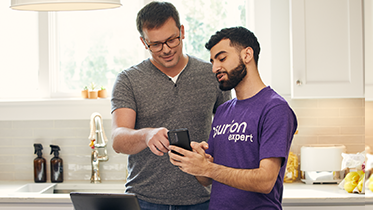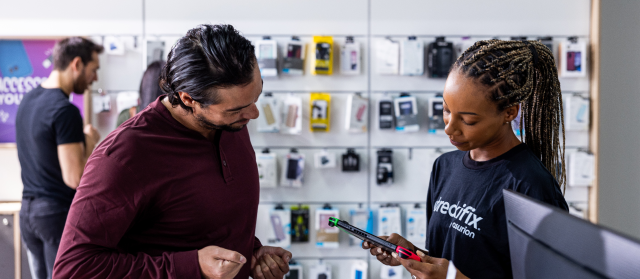Getting a computer virus is aggravating. It can not only slow down your machine and waste hours of your time as you try to fix it but also lead to permanent computer damage.
Don't know what to do if your computer has a virus? Don't worry, we do. Asurion Experts help millions of customers get the most out of their tech and resolve their device problems. They'll show you signs to look for, tell you how to get rid of a virus on your Mac® or PC, and give you tips to prevent one.
What is a virus and how do computers get them?
A computer virus is a malicious program—or form of malware—that's designed to disrupt your computer and spread to other devices. It attaches itself to a valid program, alters the code, then replicates itself to infect other files or systems. A virus can destroy data or cause your machine to stop working.
Your computer can get a virus in many ways. The most common ones are:
- Opening links or attachments in spam emails or on social media.
- Downloading programs from unreliable sites.
- Clicking on malicious ads or pop-ups.
- Sharing files with unknown users.
How to know if your computer has a virus
Think your Mac or PC may have a virus? Look for these 10 telltale signs:
- Slow performance
- Unfamiliar programs or browser extensions
- Changes to your default browser or homepage
- Your browser sending you to unwanted sites or search engines
- Frequent crashes
- Recurring error messages
- Excessive pop-ups
- Problems with computer security programs
- Missing files
- Spam messages being sent from your email or social media accounts

You can’t work when your computer doesn’t want to
Get it repaired fast at one of our stores. Just stop in or make an appointment⎯we'll handle the rest.
How to check for a virus on a Mac:
Macs have built-in protections for viruses and malware, so it's uncommon for them to become infected. So uncommon, in fact, that they don't have an option to run a manual virus scan. If you want an extra layer of protection, you can download antivirus software that will allow you to perform a scan. Popular brands include Bitdefender™, Kaspersky™, and Norton™.
How to check for a virus on a PC (Windows 10):
- Go to Start > Settings > Update & Security > Windows Security.
- Click on Virus & threat protection.
- Click on Quick scan.
How to remove a virus from your computer
If your software detects a virus, it may give you the option to remove it automatically. If it doesn't, or if you prefer to fix the computer virus on your own, you can follow these steps.
One note before starting: Getting rid of viruses manually requires knowledge of program and process names. Since these processes run in the background, it's normal not to recognize them—but that doesn't mean they're harmful. Before quitting or uninstalling a program, confirm that it is malware and doesn't belong on your machine.
How to get rid of a virus on your Mac:
- Close any open browsers.
- Cancel any downloads or installations in progress.
- Go to the Launchpad (the rocket ship icon in the bottom toolbar). Type “Activity Monitor” into the search bar and open that program.
- Under the CPU tab, look for the names of suspicious processes. Known Mac viruses include MacDefender, MacSecurity, and MacProtector.
- Once you confirm that it's malware, click on the process, then click the gray X button in the upper left of the Activity Monitor. Finally, click Force Quit.
- Open the Finder and click Downloads in the left-hand navigation. Search for any unfamiliar or unwanted downloads—especially program installer files—and drag them to the Trash.
- Click Applications in the left-hand navigation in the Finder. Look for any suspicious applications and drag them to the Trash. You may need to enter your Mac password to remove programs.
- Empty the Trash by right-clicking on it and selecting Empty Trash, then confirming it.
- Restart your Mac.
If you tried these steps and your computer is still not performing as it should, reach out to an expert for help with Mac virus and spyware removal.
How to get rid of a computer virus (Windows 10):
- Install any available updates for your computer and antivirus software.
- Reboot your computer in Safe Mode.
- Go to Start > Settings > Update & Security > Recovery.
- Under Advanced startup, click Restart now.
- After the computer restarts, click Troubleshoot > Advanced Options > Startup Settings > Restart.
- The computer will restart again, and you'll see a list of options. Select 4 on your keyboard (or F4 on some computers) to boot into Safe Mode.
- Open your browsers and look for any unfamiliar extensions. Uninstall them.
- Clear your cache and browsing history. Steps will vary based on your browser.
- In the search box next to the Start button, search for and open Control Panel.
- Click Programs > Programs & Features.
- Look for any unwanted or malicious programs. Right-click them and select Uninstall (or Uninstall/Change).
- Follow the prompts to complete the removal process.
- Open Start > Settings > Apps > Apps & features. Click on any unwanted or malicious apps and click Uninstall to remove them.
- In the Apps menu, click Startup and set any unfamiliar or malicious apps to Off.
- Run Disk Cleanup to delete temporary files.
- In the search bar, search for and open Disk Cleanup.
- Select your drive, then click OK.
- Choose what types of files you want to delete, then click OK.
- Run a virus scan to make sure you've deleted all the malware from your machine.
If you walked through the steps and your computer still acts infected, reach out to a computer expert for help with PC virus and spyware removal.
How to prevent a computer virus
Keep viruses away from your Mac or PC with these 7 helpful tips:
- Use strong passwords and change them regularly.
- Don't use more than one antivirus program at a time.
- Keep your computer and antivirus software updated.
- Only install programs and apps from reputable websites.
- Don't open emails or download attachments from unknown senders.
- Avoid using open, unencrypted Wi-Fi networks, like at an airport or coffee shop.
- Don't click on pop-up windows—close them immediately.





